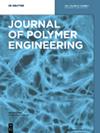通过改变电纺丝溶剂增强 Nafion 纳米纤维质子交换膜的性能
IF 1.7
4区 工程技术
Q4 POLYMER SCIENCE
引用次数: 0
摘要
纳米纤维质子交换膜(PEM)在提高燃料电池性能方面发挥着重要作用。本文以乙醇/水(E/W)和N,N-二甲基甲酰胺(DMF)为溶剂,分别制备了Nafion-E/W和Nafion-DMF两种纳米纤维质子交换膜,并考察了它们的形态、吸水率、面积膨胀、离子交换能力、电导率和机械性能等特性。结果表明,Nafion-E/W 纳米纤维的粗直径为 6,089 nm,Nafion-DMF 纳米纤维的细直径为 410 nm。然后对这两种 Nafion 纳米纤维进行退火处理,制成 PEM。与 Nafion 117 膜和 Nafion-DMF PEM 相比,Nafion-E/W PEM 的吸水率和面积膨胀率最大,分别为 59.75 % 和 30.31 %,电导率增至 0.1405 S/cm,是 Nafion 117 膜的两倍多,但断裂应力降至 5.49 MPa,几乎是 Nafion 117 膜的一半。Nafion-DMF PEM 的吸水率、面积膨胀率和电导率最低,分别为 22.67 %、10.75 % 和 0.0410 S/cm,断裂应力达到 14.20 MPa,大于 Nafion 117 膜的 11.0 MPa。实验结果对改善 Nafion PEM 的性能具有指导意义。本文章由计算机程序翻译,如有差异,请以英文原文为准。
Enhanced properties of Nafion nanofibrous proton exchange membranes by altering the electrospinning solvents
Nanofibrous proton exchange membranes (PEMs) play an important role in improving the performance of the fuel cells. In this paper, two kinds of Nafion nanofibrous PEMs, Nafion-E/W and Nafion-DMF, were fabricated respectively by using ethanol/water (E/W) and N, N -dimethylformamide (DMF) as the solvent and their properties, such as the morphologies, water uptake, area swelling, ion exchange capabilities, conductivities, and mechanical properties were examined. Nafion-E/W nanofibers showed a thick diameter of 6,089 nm and Nafion-DMF nanofibers a thin diameter of 410 nm. Then the two Nafion nanofibers were annealed to provide the PEMs. Compared with Nafion 117 membranes and Nafion-DMF PEMs, Nafion-E/W PEMs showed the greatest water uptake and area swelling of respectively 59.75 % and 30.31 % and the conductivity increased to 0.1405 S/cm, more than twice as much as Nafion 117 membranes, but the broken stress decreased to 5.49 MPa, nearly half of Nafion 117 membranes. Nafion-DMF PEMs showed the lowest water uptake, area swelling, and conductivity of 22.67 %, 10.75 %, and 0.0410 S/cm, and the broken stress reached 14.20 MPa, greater than 11.0 MPa of Nafion 117 membranes. The obtained experimental results are instructive to improve the properties of Nafion PEMs.
求助全文
通过发布文献求助,成功后即可免费获取论文全文。
去求助
来源期刊

Journal of Polymer Engineering
工程技术-高分子科学
CiteScore
3.20
自引率
5.00%
发文量
95
审稿时长
2.5 months
期刊介绍:
Journal of Polymer Engineering publishes reviews, original basic and applied research contributions as well as recent technological developments in polymer engineering. Polymer engineering is a strongly interdisciplinary field and papers published by the journal may span areas such as polymer physics, polymer processing and engineering of polymer-based materials and their applications. The editors and the publisher are committed to high quality standards and rapid handling of the peer review and publication processes.
 求助内容:
求助内容: 应助结果提醒方式:
应助结果提醒方式:


